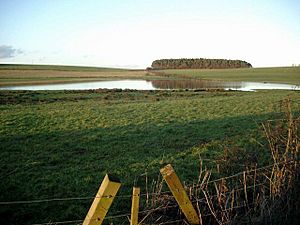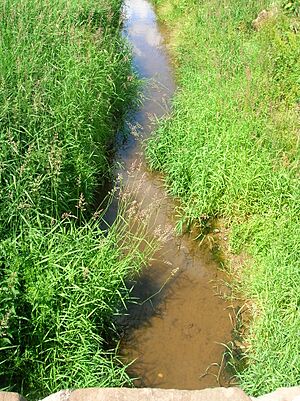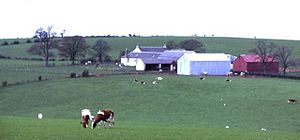Lochlea, South Ayrshire facts for kids
Quick facts for kids Lochlea, also Lochlie |
|
|---|---|

Lochlea
|
|
| Lua error in Module:Location_map at line 420: attempt to index field 'wikibase' (a nil value). | |
| Location | Tarbolton, South Ayrshire, Scotland |
| Type | Drained freshwater loch |
| Primary inflows | Rainfall and runoff |
| Primary outflows | Mill Burn |
| Basin countries | Scotland |
| Max. length | 950 m (3,120 ft) |
| Max. width | 1,450 ft (440 m) |
| Surface area | 19.675 acres (8 ha) |
| Surface elevation | 400 ft (120 m) |
| Islands | One |
| Settlements | Tarbolton |
Lochlea (pronounced 'Lochli') was a natural freshwater loch, or lake, in South Ayrshire, Scotland. It was located in a low area between the farms of Lochlea and Lochside, near Tarbolton. The loch was formed by glaciers long ago. Its waters flowed into Fail Loch, then the Mill Burn, and finally the Water of Fail. Lochlea is famous for two main reasons: it had an ancient artificial island called a crannog that was explored, and the famous Scottish poet Robert Burns lived nearby for several years. The loch was about two-and-a-half miles north-east of Tarbolton.
Contents
Exploring Lochlea's Past
The name 'Lochlea' might come from 'Liath', a Gaelic word meaning 'Grey Loch'. This loch used to be much bigger than it was in later years. The water levels changed a lot over time, which we know from studying the crannog.
Around 1840, people started draining Lochlea. This happened because a system called 'thirlage' was stopped. Thirlage meant that local farmers had to use a specific mill. When this rule ended, the Millburn Mill and its water source, Lochlea, were no longer needed as much. The land where the loch once was became part of Lochlea Farm's fields. In 1839, when the loch was being drained, two old canoes were found near the crannog. Even after drainage, the water still helped power Fail Mill, which continued to operate into the 20th century. Many of the lands around Lochlea originally belonged to the monks of Fail Monastery. The natural way the loch drained was through the Mill Burn, which flowed into a narrow valley and eventually reached Fail Loch.
William Muir was the person who rented the Mill of Fail when Robert Burns lived in the area.
Old maps show us how Lochlea changed. Blaeu's map from 1654 shows the loch, but it was less than half the size of Fail Loch at that time. Roy's map from 1747 also shows the loch and a place called 'Lochleehill'. By 1842, the loch was being drained and turned into farmland, and the mill connected to it was no longer used.
Today, the area is mostly drained, but sometimes after heavy rain, parts of it can become a seasonal loch again. In the 1950s, a local person named Shaw said that Lochlea, Fail Loch, and Tarbolton Loch were not as full of water as they used to be. They no longer supplied water for mills and were not as good for skating or curling in winter. However, they were still home to birds like snipe, geese, ducks, and swans.
Why Lochlea Was Drained
The process of draining Lochlea might have started as early as the 1700s. Landowners, like Alexander Montgomerie, 10th Earl of Eglinton, were trying to improve their farms. Drainage work also happened in the 1740s to create jobs for Irish workers during times of famine. More drainage projects took place after World War I when many soldiers returned home.
The loch might have stayed full during the time the Burns family lived there. Robert and his brother Gilbert grew flax, a plant used to make linen. They likely used the loch as a retting pond to prepare the flax.
The Crannog: An Ancient Island Home
The crannog at Lochlea was an artificial island. It was usually easiest to see during the summer months and was about 75 yards from the southern edge of the loch. Even though it was there when Robert Burns lived nearby, he never wrote about it. A wooden path led to the crannog from the south-east side of the loch. At least five dugout canoes were found some distance away from the crannog.
By 1878, the land around the crannog had become marshy again. Its rediscovery led to an excavation, which is like an archaeological dig. The Duke of Portland owned Lochlea Farm and the crannog site. His manager, Mr. Turner, helped organize the dig with Mr. Cochrane-Patrick. The crannog was built mostly with wood from oak, hazel, birch, alder, and poplar trees. Animal bones found there included sheep, roe deer, red deer, reindeer, pigs, and horses.
The crannog was used at different times in history. Archaeologists found a ringed pin from the 9th century. They also found items from the 16th or 17th century, like a brass-handled knife and several iron tools. The crannog measured about 33 meters (108 feet) from east to west and 23 meters (75 feet) across.
Robert Burns's Time at Lochlea
Lochlea Farm became home to the famous poet Robert Burns in 1777. His father, William Burnes, moved the family here from Mount Oliphant. David McLure, a merchant from Ayr, owned the 130-acre farm and the loch.
Robert Burns lived at Lochlea until 1784, when he moved to Mossgiel Farm near Mauchline. He had spent about nine difficult months away in Irvine learning how to process flax. The farmland at Lochlea was very wet and marshy. William Burnes had trouble paying the high rent. He even won a court case against the landlord, but this used up his savings. This stress may have contributed to his early death in February 1784.
It is said that Robert Burns himself helped build the barn roof at Lochlea. When the barn was later taken down, a special engraved stone from it was put into the new farmhouse. By 1879, the poet's old home had become a barn.
In the early 1780s, William Burnes had a spoken agreement to pay rent for the land covered by the mill dam, which included the loch. However, David McClure had not yet drained this land, so William argued that he should not have to pay for it.
William Ronald was a "gauds boy" who helped Burns at Lochlea Farm. He would guide the horses while ploughing and clean the plough when it got stuck in the earth. He later became a farmer himself.
Robert Burns's sister, Isabella Burns, remembered a nursery story called "The Marriage of Robin Redbreast and the Wren." Robert Burns had written this story and used it to entertain his younger brothers and sisters at Lochlea.
Highland Mary
Burns met a woman named Mary Campbell, also known as 'Highland Mary', in church while he was living near Tarbolton. One of his songs, "Will ye go to the Indies, my Mary, And leave auld Scotia's shore?", suggests they planned to move to Jamaica together. Sadly, she became ill and died in Greenock. Burns and Mary Campbell are said to have exchanged Bibles over a stream near Coilsfield or Failford. They may have also made traditional Scottish marriage promises on the banks of the River Ayr, either at Failford or near Coilsfield.
Other Interesting Facts About Lochlea
James Thom, a famous sculptor who created statues of Robert Burns, was born near Lochlea.
Two coal mines, Lochlea 1 and 2 collieries, operated near the farm from 1949 to 1973. Today, not much remains to be seen of them.
Lochlea is also a site where people count wildfowl (water birds) as part of a Wetland Bird Survey (WEBS).




